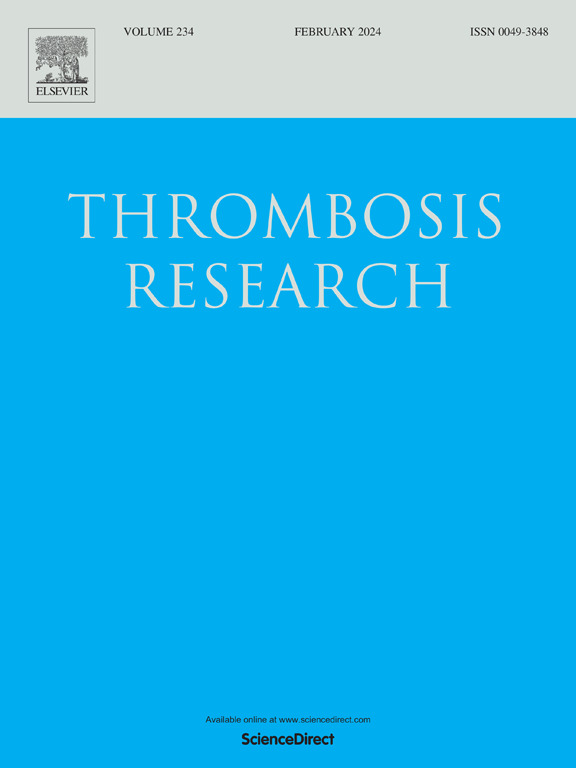Chemotherapy alters thrombomodulin and factor VIIIc expression resulting in acquired activated protein C resistance and enhanced thrombin generation in cancer associated thrombosis
IF 3.7
3区 医学
Q1 HEMATOLOGY
引用次数: 0
Abstract
Background
Tumour type, treatment and patient related factors contribute to cancer associated venous thromboembolism (VTE), however, the role of each factor and the mechanisms involved are not understood.
Aim
To assess the role of the tumour, and of chemotherapy, in mediating the procoagulant response associated with VTE in gynaecological cancer patients.
Methods
Gynaecological cancer patients who developed VTE during follow-up (n = 59) (VTE+) were matched with treatment naïve(treatment (−)(VTE-)(n = 120) and chemotherapy treated patients(treatment (+)(VTE-) (n = 57)). Thrombin generation, Factor V(FV), VIIIc(FVIIIc), Tissue Factor Pathway Inhibitor(TFPI), soluble Thrombomodulin(sTM), Protein S(PS), C(PC) endothelial protein C receptor(EPCR) and fibrinogen were compared in each group. EPCR and TM expression was assessed in EA.hy926 cells in vitro following addition of chemotherapy agents. mRNA expression of coagulation genes was measured in tumour biopsies.
Results
Thrombin generation was increased in treatment(−)VTE(+) compared with treatment(−)VTE(−) controls but not in the treatment(+)VTE(+) patients. Using the TM modified assay, thrombin generation was increased in the treatment (+)VTE(−) group compared with treatment(−)(VTE-) with a further increase in the treatment (+) VTE(+) group. Reduced levels of sTM in treatment (+) VTE(+) patients correlated with thrombin generation. TM expression was reduced in vitro by carboplatin and paclitaxel. FVIIIc was increased in both VTE groups and was predictive of VTE. F5 mRNA levels were lower in tumours from VTE(+) patients compared with controls.
Conclusion
Chemotherapy alters sTM and confers an acquired activated Protein C(aPC) resistance which may be implicated in cancer associated VTE in gynaecological cancer patients. FVIIIc may be a useful predictive marker for VTE in cancer patients in this setting.

化疗改变凝血调节蛋白和凝血因子viii的表达,导致获得性活化蛋白C抵抗和增强凝血酶生成。
背景:肿瘤类型、治疗和患者相关因素可导致癌症相关性静脉血栓栓塞(VTE),然而,每种因素的作用及其机制尚不清楚。目的:评估肿瘤和化疗在介导妇科癌症患者静脉血栓栓塞相关的促凝反应中的作用。方法:随访期间发生VTE的妇科肿瘤患者(n = 59) (VTE+)与治疗naïve(治疗(-)(VTE-)(n = 120)和化疗(治疗(+)(VTE-) (n = 57)相匹配。比较各组凝血酶生成、凝血因子V(FV)、凝血因子viii (FVIIIc)、组织因子途径抑制剂TFPI、可溶性凝血调节蛋白sTM、蛋白S(PS)、C(PC)内皮蛋白C受体EPCR、纤维蛋白原。体外观察化疗药物对EA.hy926细胞EPCR和TM表达的影响。在肿瘤活检中检测凝血基因mRNA的表达。结果:治疗(-)VTE(+)组与治疗(-)VTE(-)组相比凝血酶生成增加,但治疗(+)VTE(+)组无凝血酶生成。使用TM修饰法,治疗(+)VTE(-)组与治疗(-)(VTE-)组相比,凝血酶生成增加,治疗(+)VTE(+)组进一步增加。治疗组(+)VTE(+)患者sTM水平降低与凝血酶生成相关。体外卡铂和紫杉醇均可降低TM的表达。两组VTE患者fviic均升高,可预测VTE的发生。与对照组相比,VTE(+)患者肿瘤中F5 mRNA水平较低。结论:化疗改变了sTM,并赋予获得性活化蛋白C(aPC)耐药性,这可能与妇科癌症患者的癌症相关性静脉血栓栓塞有关。在这种情况下,fviii可能是癌症患者静脉血栓栓塞的有用预测指标。
本文章由计算机程序翻译,如有差异,请以英文原文为准。
求助全文
约1分钟内获得全文
求助全文
来源期刊

Thrombosis research
医学-外周血管病
CiteScore
14.60
自引率
4.00%
发文量
364
审稿时长
31 days
期刊介绍:
Thrombosis Research is an international journal dedicated to the swift dissemination of new information on thrombosis, hemostasis, and vascular biology, aimed at advancing both science and clinical care. The journal publishes peer-reviewed original research, reviews, editorials, opinions, and critiques, covering both basic and clinical studies. Priority is given to research that promises novel approaches in the diagnosis, therapy, prognosis, and prevention of thrombotic and hemorrhagic diseases.
 求助内容:
求助内容: 应助结果提醒方式:
应助结果提醒方式:


